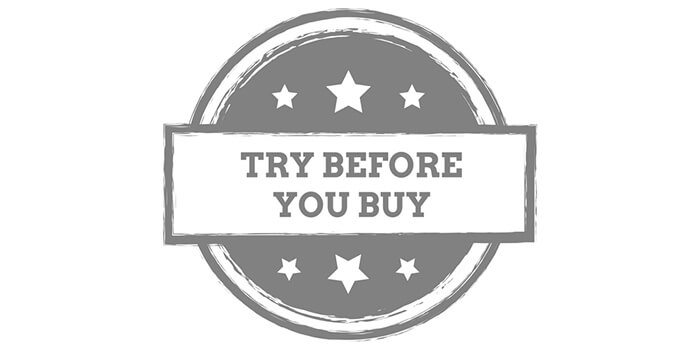Let’s say you are in WordPress business for a few years and you try to discuss its advantages with someone uninformed. If you just claim you make money with WordPress, they would probably say: “Oh, WordPress is a widely known platform, a lot of free designs are developed for it, all components for building a website are possible to get for free, so how can you earn with WordPress?”
No need to dispute with uninformed folks, ‘cause you and me are sure to know that cool premium solutions like themes and plugins can bring good revenue both when you create them or just promote them on your website.
However, it’s very important to know the key marketing principles and main rules that are going to bring you success in your nature of business. In this post, we’ll discuss two marketing strategies widely used when selling a WordPress product, and we will try to resolve which one is more efficient and why.
Give It a Try!

First, let’s see what a standard purchasing process looks like and what a customer expects to get when buying a certain product.
For instance, when a man wants to buy a coat, he visits a clothes store, chooses an appropriate model, and then he needs a consultation of a seller to find out the main qualities and virtues of this piece of clothes. All of this will help a customer resolve whether to fit this coat on or not, and whether to purchase it or just go to another store.
So, the main task of a seller is to follow the 3 main steps:
- represent the product itself;
- show off its features;
- give a chance to try it.
The same formula works when you sell a digital product, these steps are aimed to make a customer get interested in processing the order and buying this product right from your inventory.
When a customer tries the product before purchasing (fits it on, holds it in their hands), it helps to build trust between a buyer and a seller as well as creates absolute transparency for a customer. So both a seller and a buyer build their relationships based on safeness, and this is a component of success. A customer feels full control over a purchase process and a seller can make sure their product meets major customer needs.
So let’s see how it works with WP products.
Online Demo and Free Trial

A WP plugin or a theme are not tangible products, so a customer isn’t able to be sure in their quality until they try them.
Every WordPress theme on the market is available with a live preview where a potential buyer can see and review a few demos, learn the structure of every page, etc. Some developers allow testing a theme from the back-end and they provide potential buyers with access to a dashboard available on a test server.
A free demo is a way to give customers a chance to try a product before buying it. This strategy is effective for small theme and plugin developers selling their products, for instance, at Themeforest or Codecanyon.
Some WordPress developers provide a customer with a chance to take a plugin or any other solution for a free trial period. Customers can download a premium product for free and use it for their own purposes during a limited period of time. After the end of this trial period, a customer can either buy the full version of a product (for instance a plugin) or refuse from buying it. This strategy allows a customer to make sure they pay for a product which really suits their needs, so they feel confident and safe about the purchase.
Before you launch a trial version of your product, consider some of the following aspects:
1. Define a Perfect Trial Time
The standard trial period usually includes 30 days. However, different WordPress products suppose different features and functionality, so they require different periods of time to be tested and evaluated by a customer.
Try the functionality of your product by yourself and consider the time required for a regular user to learn how to apply its every function. Remember that a short trial period creates a sense of urgency which makes users act and decide faster. A happy medium in this case can include 14-15 days.
2. Focus on a User
According to the opinion of experienced marketing strategists, human interaction is very important for building trustful relationships between a customer and a product provider. So, if you give a user the ability to try your plugin or any other solution for free, make the following steps:
- provide live support service in addition to the FAQ page link;
- send follow-up emails;
- send reminder emails;
- be always ready to help (create a live chat, an email box to communicate with customers, a forum, etc.).
Interact with a user as much as possible to make them feel support and trust, show them you are interested in their satisfaction with your product.
3. Credit Card Upfront?
Many product developers require credit card credentials to input while signing up for a free trial. This sometimes scares clients ‘cause they think that the purchase will be obligatory. So they quit the registration process and resolve not to take a product for a trial period. You can refuse this method for a while to make a “free trial strategy” work more effectively.
Money-Back Guarantee. Is it Worse or Better?

Money-back guarantee is another marketing strategy that is used by some developers selling their WP products.
The essence of this strategy supposes that a buyer pays for a product considering it to be a test drive. In this case, a customer has no doubts or worries because they are sure they will be able to get a refund according to the developer’s policy. Sometimes it is not easy for a customer to get their money back, because the refund policy can include the contradictory terms.
What are the risks for a developer (a product or service provider)?
- If a customer is unhappy with a product in one or two aspects and they can’t get a refund according to your policy, they won’t come back to buy new things. They can also leave negative feedback about your product.
- If a product meets all the customer’s requirements but a customer knows they can get a refund and then buy the same product from your competitor (selling it at a lower price) they are sure to demand their money back.
- If your competitor’s product has a free trial period, a customer doesn’t care about your money-back guarantee. They can try the same product for free without any additional hassle (any payments and refunds).
If you provide both a free trial and money-back guarantee services, you can be sure that a free trial period decreases the number of cancellations and refunds. You give customers enough time to try a product and decide whether it meets their needs and purposes without paying for it in advance.
Conclusion:
As you’ve probably understood, we consider a free trial to be more effective than a money-back guarantee strategy when it comes to WordPress marketing. If you’ve got any concerns as to the efficiency of a free trial marketing strategy, just take your time to learn the sales statistic from any trusted resources you prefer. Compare the WP products offered with a free trial period and those that are sold just without any demo or trial available. You’ll be able to count the approximate revenue of both product developers and then compare and evaluate the level of every developer’s profit on your own.






